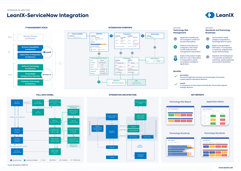What is technology risk?
Technology risk or technical risk specifically refers to the potential for financial losses, operational disruptions, and damage to an organization's reputation due to failures or security breaches within its technology systems.
This risk arises from various sources, including legacy systems, cyber-attacks, software malfunctions, hardware failures, and data integrity issues, all of which directly impact business operations and strategic outcomes.
Effective technology risk management integrates the identification, assessment, and prioritization of these risks, employing strategic mitigation and response strategies.
It protects the organization's digital assets, ensures regulatory compliance, and aligns IT performance with business goals.
📚 Related: Obsolescence Risk Management Solution
Types of technology risks
Technology risks can generally be categorized into several types, each with its unique characteristics and potential impacts on organizations.
Understanding these categories helps in identifying, assessing, and mitigating risks more effectively.
- Software risks: This category includes risks related to software development and deployment, such as bugs, security vulnerabilities, and compatibility issues. Software risks can lead to system failures, data breaches, and operational disruptions.
- Hardware risks: Risks associated with physical components of IT infrastructure, including servers, workstations, and networking equipment. Hardware malfunctions can result in data loss, downtime, and reduced operational capacity.
- Technology obsolescence risks: Outdated technology no longer maintained and supported well bears the risk of breaches, increased downtimes, and system crashes. Tackling these ensures business continuity from a technology perspective, invests available resources wisely and efficiently, and builds a tech stack that remains relevant, effective, and functional.
- Cybersecurity risks: Encompasses threats from malicious cyber activities such as hacking, malware, ransomware, and phishing attacks. Cybersecurity risks can compromise sensitive data, disrupt business operations, and damage an organization's reputation.
- Project management risks: These risks arise from the management of technology projects, including poor planning, inadequate resource allocation, and scope creep. They can lead to project delays, cost overruns, and failure to meet objectives.
- Compliance and regulatory risks: Involves the risk of failing to comply with industry regulations and standards, which can result in legal penalties, fines, and reputational damage. Compliance risks are particularly relevant in sectors like finance, healthcare, and telecommunications.
- Operational risks: Related to the day-to-day operation of technology systems and processes. Operational risks include system downtime, performance issues, and the failure of backup and recovery systems.
- Supply chain risks: Stem from dependencies on external suppliers and partners for technology components and services. Disruptions in the supply chain can lead to production delays, increased costs, and compromised product quality.
- Innovation risks: Associated with adopting new technologies or business models. While innovation is crucial for staying competitive, it carries risks such as unproven technologies, integration challenges, and unanticipated market reactions.
📚 Related: 5 Legacy Technology Risks
Impact of technology risks

Image: Technology Lifecycle vs. Value & Risk
The impact of unmanaged technical risk can be profound, affecting an organization's operational efficiency, financial health, and reputation. It can lead to:
- Unplanned downtime, significantly disrupting operations.
- Increased costs due to emergency repairs, data recovery, and legal liabilities.
- Loss of customer trust and competitive edge due to compromised service quality.
- Project failures or delays, impacting overall strategic objectives.
Real-world technology risk examples
- Software failure: Knight Capital Group (2012) Knight Capital, a global financial services firm, suffered a devastating software failure due to a faulty deployment of trading algorithms. Within minutes, unintended orders caused a loss of $440 million. This incident underscores the critical importance of rigorous software testing and deployment protocols to prevent costly errors.
- Hardware malfunction: British Airways IT Outage (2017) British Airways experienced a massive IT outage caused by a hardware failure in its data center, leading to the cancellation of over 670 flights during a busy holiday weekend. The failure, reportedly due to a power supply issue, resulted in estimated losses of £80 million and highlighted the need for robust hardware maintenance and disaster recovery planning.
- Innovation challenges: Healthcare.gov Launch (2013) The initial launch of Healthcare.gov, the online marketplace for health insurance under the Affordable Care Act, faced significant challenges due to technical issues, including system overloads and integration problems with existing insurance databases. This example illustrates the risks associated with deploying new, complex IT systems without adequate testing and scalability planning.
- Cybersecurity threat: WannaCry Ransomware Attack (2017) The WannaCry ransomware attack exploited vulnerabilities in outdated Windows systems, affecting over 200,000 computers across 150 countries, including critical sectors like healthcare (notably the UK’s NHS), banking, and telecommunications. The attack emphasized the critical need for regular software updates and comprehensive cybersecurity measures.
- Regulatory compliance risk: Facebook and GDPR (2018) Facebook faced significant scrutiny and financial penalties under the European Union’s General Data Protection Regulation (GDPR) for privacy violations. This situation underscores the technical risks associated with non-compliance to evolving regulatory standards and the necessity for ongoing privacy and data protection measures.
- Supply chain disruption: Toyota’s Airbag Recall (2016) Toyota, along with other automakers, was forced to recall millions of vehicles due to faulty airbag inflators supplied by Takata, a key supplier. The recalls, affecting the global automotive industry, highlight the risks of supply chain dependency and the importance of diversified sourcing and quality assurance practices.
These examples span various industries and demonstrate how technical risks, if not properly managed, can lead to significant financial, operational, and reputational damages.
They reinforce the importance of a proactive approach to identifying, assessing, and mitigating technical risks to safeguard organizational interests.
📚 Related: The Why Behind the Technology Obsolescence Management




/EN-Tech-Stacks-Poster_Resource_Page_Thumbnail.png?width=260&height=171&name=EN-Tech-Stacks-Poster_Resource_Page_Thumbnail.png)


